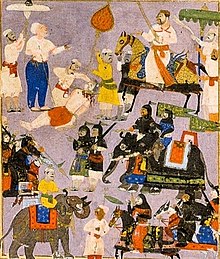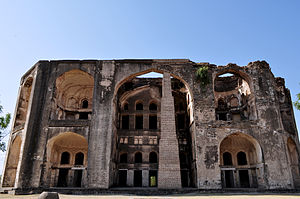The Deccan sultanates were five late-medieval Indian kingdoms—on the Deccan Plateau between the Krishna River and the Vindhya Range—that were created from the disintegration of the Bahamani Sultanate and ruled by Muslim dynasties: namely Ahmadnagar, Berar, Bidar, Bijapur, and Golconda. The sultanates had become independent during the break-up of the Bahmani Sultanate. The five sultanates owed their existence to the declaration of independence of Ahmadnagar in 1490, followed by Bijapur and Berar in the same year. Golconda became independent in 1518, and Bidar in 1528.
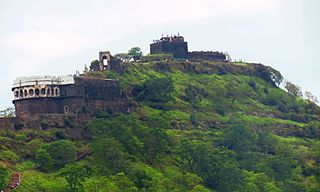
DaulatabadFort originally DeogiriFort, is a historic fortified citadel located in Daulatabad village near Aurangabad, Maharashtra, India. It was the capital of the Yadavas, for a brief time the capital of the Delhi Sultanate, and later a secondary capital of the Ahmadnagar Sultanate.

Shahaji Bhosale was a 17th century Indian military leader who served the Ahmadnagar Sultanate, the Bijapur Sultanate, and the Mughal Empire at various points in his career. As a member of the Bhonsle dynasty, Shahaji inherited the Pune and Supe jagirs (fiefs) from his father Maloji, who previously served the Ahmadnagar Sultanate. During the Mughal invasion of the Deccan, Shahaji joined the Mughal forces and served under Emperor Shah Jahan for a short period. After being deprived of his jagirs, he defected to the Bijapur Sultanate in 1632 and regained control over Pune and Supe. In 1638, he received the jagir of Bangalore after Bijapur's invasion of Kempe Gowda III's territories. Afterwards, he became the chief general of Bijapur and oversaw its expansion.

Malik Ambar was a military leader who served as the Peshwa of the Ahmadnagar Sultanate in the Deccan region of India.

Khuldabad is a city and a Taluka of Aurangabad district in the Indian state of Maharashtra. It is known as the Valley of Saints, or the Abode of Eternity, because in the 14th century, several Sufi saints chose to reside here. The Bhadra Maruti Temple and Dargah of Zar Zari Zar Baksh, Shaikh Burhan ud-din Gharib Chisti and Shaikh Zain-ud-din Shirazi, along with the tomb of the Mughal emperor Aurangzeb and his trusted General Asif Jah I, the first Nizam of Hyderabad, are located in this town. It is a holy and spiritual city of Islamic saints.
Berar Sultanate, also known as the Imad Shahi Sultanate was an early modern Indian kingdom in the Deccan peninsula. It was one of the Deccan sultanates and established in 1490 following the disintegration of the Bahmani Sultanate, and was annexed by Ahmadnagar in the 1572 invasion.
The Farooqi dynasty or the Farooq Shahi was the ruling dynasty of the Khandesh Sultanate from its inception in 1382 till its annexation by the Mughal emperor Akbar in 1601. The founder of the dynasty, Malik Ahmad participated in a rebellion against the Bahmani ruler Muhmmad Shah I in his early years. When he was compelled to flee from Deccan, he established in Thalner on the Tapti River. After receiving the grant of the fiefdoms of Thalner and Karanda from Firuz Shah Tughluq in 1370, he conquered the region around Thalner, which later became known as Khandesh. By 1382, he started ruling independently.
Qasim Barid I was prime-minister of the Bahmani sultanate and the founder of the Bidar Sultanate, one of the five late medieval Indian kingdoms together known as the Deccan sultanates.

Narnala Fort or Narnala Qila Sarkar, also known as Shahnoor Fort, is a hill fortress in the Satpura Range of Vidarbh, Maharashtra, India, named after the Rajput Solanki Chaulukya Ruler, Raja Narnal Singh, also known as Narnal Singh Swami. It was renamed as "Shahnoor" by Islamic rulers but again acquired, rebuilt and got its name "Narnala" by ruler Rao Rana Narnal Singh Solanki, who migrated from Patan in Gujarat.
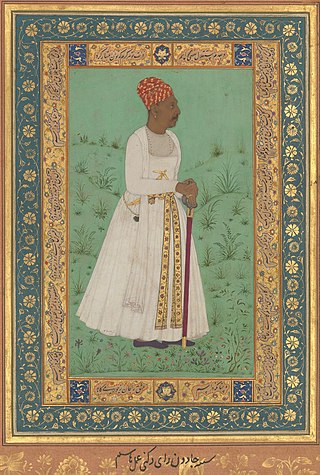
Lakhuji Jadhav Rao, also known as Lakhuji Jadhav was a Maratha statesman and Mansabdar who initially served the Ahmadnagar Sultanate and later joined the Mughals. He was a prominent figure in the politics of Deccan. Lakhuji was a well-known member of Jadhav Rao clan who claim to be descendants of the Yadavas of Devagiri who were originally Cowherds Gavlis. He was also a Jagirdar of Sindkhed Raja. He was father of Jijabai, and grandfather of Shivaji, who was founder of the Maratha Empire.
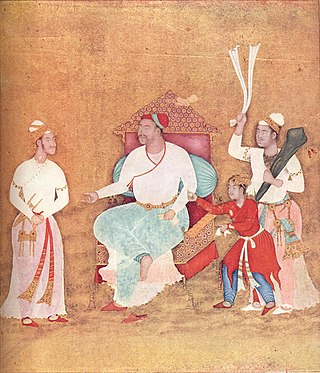
Burhan Nizam Shah II was the ruler of Ahmadnagar Sultanate in the Deccan. He was the second son of Hussain Nizam Shah I and Khunza Humayun Begum.
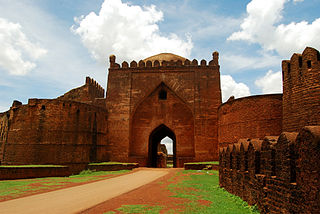
Deccani architecture, particularly the architecture of the Bahmani and Deccan Sultanates, is the architecture of the Deccan Plateau, and is a regional variant of Indo-Islamic architecture. It was influenced by the styles of the Delhi Sultanate and later Mughal architecture, but sometimes also influenced from Persia and Central Asia. Hindu temple architecture in the same areas had very different styles.
Malik Ahmad Nizam Shah was the founder of the Nizam Shahi dynasty and the Ahmadnagar Sultanate.
Pushkar Sohoni is an architect, and an architectural and cultural historian. He is an associate professor and the chair of the department of Humanities and Social Sciences at the Indian Institute of Science Education and Research, Pune.

Murtaza Nizam Shah II was the Sultan of Ahmadnagar from 1600 to 1610. His rule was dominated by the powerful regent Malik Ambar, under whom he was an effective puppet ruler.
The Battle of Bhatvadi was fought in 1624, near modern Bhatodi Pargaon village in Maharashtra, India. The Ahmadnagar army led by Malik Ambar defeated a combined Mughal-Bijapur force led by the Bijapuri general Mullah Muhammad Lari.
Sabaji Koli was the commander-in-chief of the army of Ahmednagar Sultanate. Sultan Burhan Nizam Shah of Ahmednagar conferred the title of Parvat Rai on Sabaji Koli. After the Sultan's death, Koli fought against the Vijayanagara Empire during the reign of the new Sultan Husain Nizam Shah. Burhan Nizam Shah also used to call Sabaji Koli Prataparaja, Parashurampratap and Narasimha Pratap.

The Architecture of a Deccan Sultanate: Courtly Practice and Royal Authority in Late Medieval India is a book by the architectural and art historian Pushkar Sohoni, published in 2018 by I.B. Tauris. It is one of the most comprehensive works on the architecture and urban settlements of the Nizam Shahs of Ahmadnagar, who ruled in the sixteenth century.
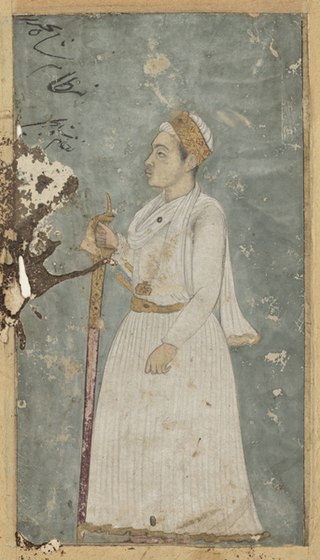
Burhan Nizam Shah III was the ruler of the Ahmadnagar Sultanate from 1610 until his death in 1631.

The Tomb of Malik Ambar is a mausoleum located in Khuldabad, in the Indian state of Maharashtra. It is the burial place of Malik Ambar, a military leader who served as the prime minister of the Ahmadnagar Sultanate. Ambar built the tomb for himself, and was interred here upon his death in 1626. It is listed as a monument of national importance.



